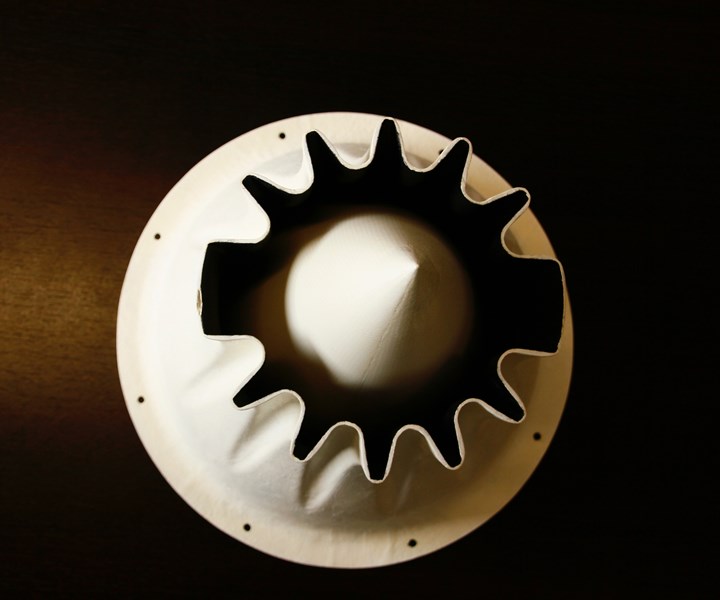Composite Resources, Pyromeral form manufacturing alliance
Composite Resources will use Pyromeral materials and processes to fabricate composite parts and structures for high-temperature defense applications.

Engine cone made with Pyromeral’s PyroXide oxide/oxide composite material. Source | Composite Resources/Pyromeral
Composites fabricator Composite Resources (Rock Hill, S.C., U.S.) reports that it has created a manufacturing alliance with high-temperature materials and process specialist Pyromeral (Barbery, France). Under the terms of the alliance, Composite Resources will use Pyromeral materials and processes to fabricate composite parts and structures for high-temperature defense applications.
Mel Clauson, director of business development at Composite Resources, says Pyromeral’s French heritage, combined with ITAR restrictions, has made it difficult for the company to break into the U.S. defense market. Composite Resources, says Clauson, will provide a “firewall between Pyromeral and defense and other ITAR-sensitive customers in the U.S.”
Pyromeral, which was founded in 1984, manufactures raw materials as well as finished parts for high-temperature applications. It produces three materials. PyroSic and PyroKarb are based on proprietary glass-ceramic matrix systems reinforced with silicon carbide (PyroSic) or carbon fibers (PyroKarb). Thanks to the use of advanced inorganic polymers, they are processed at low temperatures with the same techniques and tooling as those used for conventional carbon-fiber reinforced plastics (CFRP).
PyroSic has a service temperature of 700°C and offers tensile strength of 300 300 MPa, flex strength of 350-400 MPa and flex modulus of 45 GPa. PyroKarb has a service temperature of 350°C and offers tensile strength of 250 MPa, flex strength of 250-300 MPa and flex modulus of 50 GPa. Both materials are fire resistant and have a coefficient of thermal expansion (CTE) of 3 μm/m/K.
The third material, and the newest, is PyroXide, an oxide/oxide composite designed for long exposure at very high temperatures. PyroXide comes in two variations. One uses 3M’s Nextel 610 ceramic oxide with an alumina matrix. It has a creep limit of 1000°C, tensile strength of 300 MPa, flex strength of 350 MPa, flex modulus of 70 GPa, interlaminar strength of 10 MPa and a CTE of 8 μm/m/K. The other PyroXide variation uses 3M’s Nextel 720 ceramic oxide fibers, also with an alumina matrix. It has a creep limit of 1150°C, flex strength of 250 MPa and a CTE of 6 μm/m/K.
Potential applications of these materials include exhaust systems, heat shields, radomes and hypersonic structures. “There does seem to be a lot of interest in this technology in the U.S. right now,” Clauson notes. “There is definitely a ‘pull’ for this material solution.” Contact Clauson directly for more information.
Related Content
-
Industrializing additive manufacturing in the defense/aerospace sector
GA-ASI demonstrates a path forward for the use of additive technologies for composite tooling, flight-qualified parts.
-
TenCate Advanced Armour renamed to Integris Composites
With its rebranding, Integris maintains the ability to develop, test and manufacture ballistic armor and survivability solutions while expanding into new markets where composite solutions can be advantageous.
-
From the CW Archives: Airbus A400M cargo door
The inaugural CW From the Archives revisits Sara Black’s 2007 story on out-of-autoclave infusion used to fabricate the massive composite upper cargo door for the Airbus A400M military airlifter.
















